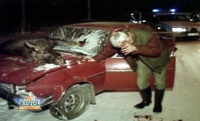New Safety Technology from Volvo Helps Avoid Collisions with Animals - VIDEO ENHANCED
 New Volvo braking system will help avoid accidents with wild animals |
SEE ALSO: Pedestrian Detection with Full Auto Brake from Volvo
GOTHENBURG - June 15, 2011: Volvo Car Corporation is taking the next step in active safety by developing a system that alerts and automatically brakes for animals on the road. The new system will be launched on the market in a few years’ time.
The project to develop a safety system that reduces the risk of collisions with wild animals is part of Volvo Car Corporation's vision for 2020 – that nobody should suffer serious injury in a new Volvo. The new system is based on technologies from the Pedestrian Detection with Full Auto Brake, introduced in 2010.
Click PLAY to watch video story
Camera and infra-red light
“The system consists of two parts – a radar sensor and an
infra-red camera that can register the traffic situation,” relates
Andreas Eidehall, technical expert in the field of active safety systems at
Volvo Car Corporation. It is essential for the system to also function in
the dark since most collisions with wild animals take place at dawn and
dusk and during the dark winter months. The camera monitors the road ahead
and if an animal is within range the system alerts the driver with an
audible signal. If the driver does not react, the brakes are automatically
applied. “The goal is for the system to function at the normal rural
highway speeds. In cases in which it cannot help the driver entirely avoid
the collision, the system will slow down the car sufficiently to help
reduce the force of impact and thus of serious injuries,” continues
Andreas Eidehall.
Data interpretation
One challenge facing the engineers is to teach the system to recognise
different animals. A development team from Volvo Car Corporation spent an
evening at a safari park digitally logging film sequences of animals and
their various behavioural patterns. On this particular evening the focus
was on moose, red deer and fallow deer. By driving very slowly along a
trail where fodder had been laid out to attract the animals, a lot of data
was recorded and this will later be used to evaluate and develop the sensor
system. In the first stage, the system will respond to large animals that
risk injuring the driver or passengers in an impact, such as moose, deer
and reindeer.
Immense risks from collisions with wild animals
Many car drivers are highly concerned about the risk of collisions with
wild animals. There is good reason for this concern. In Sweden alone, more
than 40,000 accidents involving wild animals are reported every year. The
greatest danger is from collisions with moose. “In an impact with a
moose there is a relatively high risk of personal injury since it is common
for the animal to end up on or roll across the front of the car and its
windscreen,” says Andreas Eidehall.
As regards the system and its various functions, Andreas cannot be more specific. The project has been under way for just over a year and a lot of work still remains to be done. Various technologies are currently being evaluated, software is being developed and while the system “learns” to recognise various animals, development is also under way on the necessary decision-making mechanisms, that is to say how and when the protective system is to respond. “We can see in our accident statistics that this is an important area to prioritise. What is more, we know that there is considerable market interest in this type of safety system. During demonstrations of Pedestrian Detection with Full Auto Brake, we were often asked about protection from accidents with wild animals. We will present a market-ready system within a few years,” concludes Andreas Eidehall.
Facts, road accidents with wild animals:
The number of road accidents involving wild animals, Sweden: in 2010
just over 47,000. Source: Swedish Advisory Council on Accidents Involving
Wild Animals Accidents with moose: About 7,000. Source: Swedish Advisory
Council on Accidents Involving Wild Animals. Statistics based on
Volvo’s accident database reveal that collisions with moose involve a
high risk of injury. The US Insurance Institute for Highway Safety has
compiled statistics for the period 1993-2007. All told, 2,499 people died
in road accidents involving animals during this period. The report also
states that the number of road accidents involving wild animals increases
by almost 30 percent in November. The largest insurance company in the USA,
State Farm, reports that the number of compensation claims for road
accidents involving wild animals rose by 14.9 percent between 2003 and
2008.


